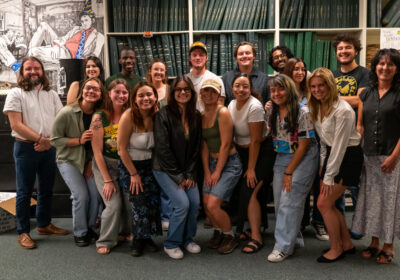Fit 5: Benefits of the ropes course
Fit Five is a column by health science major and USF track sprinter Shannon Gordon. Drawing from her education and experience, Gordon lists five ways to improve health and fitness.
Anyone whos visited USFs Riverfront Park, located east of campus on Fletcher Avenue, might have noticed its large, wooden jungle gym. Though this ropes course is usually uninhabited, this weekend it will be open for anyone looking to get a workout high above the ground.
This Saturday, the Campus Recreation Center is holding an open house for the high ropes course, which is about three miles away from the Marshall Student Center. With spring officially in full swing and bringing prime weather with it, the event is a great excuse to get outside and try something new. The open house will go from 9 a.m. to 4 p.m. and costs $10 for USF students. The high ropes course is 55 feet tall with three different levels and 25 elements.
The course requires a proficient amount of physical strength and flexibility, but it is more enjoyable and gratifying than it is physically taxing. The course is usually done with a large group of people, so teamwork is a must. It is a positive way to keep your mind engaged while relieving stress and tension building up before exam time kicks in. So get outside and get climbing.
1. Upper body strength
The upper body benefits the most from the physical challenges of the course because the muscles in the hands, forearms and upper arms are engaged substantially. The muscles most effectively targeted in rope climbing are the biceps brachii and the brachialis, which are both located on your upper arms.
These muscles are responsible for bending your elbow and helping you climb. The variety of climbing techniques within the ropes course can help increase overall body strength.
2. Working overlooked muscles
Built entirely of rope and wooden beams, the course requires balance and concentration. Many sports and exercise activities incorporate repetitive techniques, so the muscles not incorporated in these exercises may be extremely weak.
Balance exercises incorporate the muscles located in the spine, abdominals and back, which are often looked over in recreational activities. These muscles are extremely important for a healthy and injury-free body. Strong back muscles and abdominals help improve balance and flexibility.
3. Lower body strength
Balance exercises are also extremely important for enhancing and strengthening the muscles in the lower leg, which contribute to the movement and support of the ankle.
Ankle strength is necessary for good balance, increased performance and reducing the chance of injuries from everyday activities and challenges.
4. Team building
The course not only strengthens and stretches muscles, but also builds teamwork and enhances risk-taking and communication skills. The course puts climbers in positions that cannot be worked through individually.
Each team will have to work together and communicate effectively to get through each challenge. Teams will experience conflict and will have to engage in conflict resolution and proper decision making to get through the course.
5. Boosts self-confidence
The challenges of the course help instill positive personality characteristics like self-esteem and trust in the climber.
By pushing you to reach certain personal achievements within the course, self-confidence is built and strengthened. The course expands climbers comfort zones and introduces situations that may help them conquer certain fears, as well as enhance their trust in their teammates.







